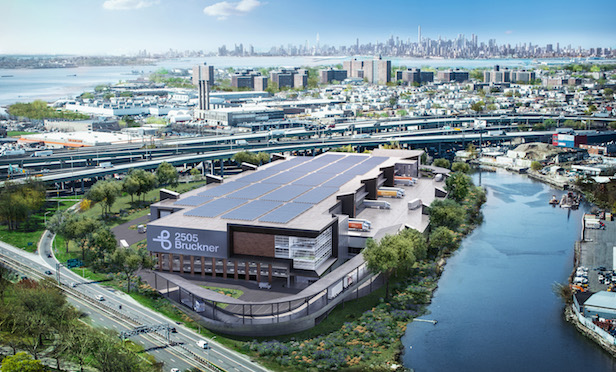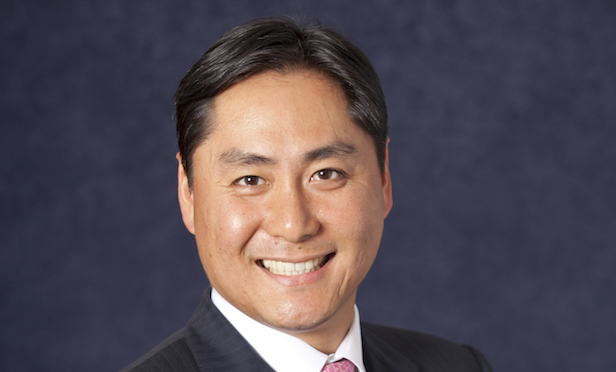 2505 Bruckner Ave., industrial warehouse in the Bronx/ architectural rendering provided by Innovo Property Group
2505 Bruckner Ave., industrial warehouse in the Bronx/ architectural rendering provided by Innovo Property Group
NEW YORK CITY—Innovo Property Group and Square Mile Capital are building a 700,000 square-foot multistory industrial warehouse on 20 acres at 2505 Bruckner Blvd. in the Bronx. Unique factors driving the demand behind the project include “the combination of a highly dense, highly trafficked area and very impatient people,” says Andrew Chung, Innovo's CEO.
His company saw a game changer—the trend from e-commerce demanding faster and faster delivery. It's the convenience of online shopping with the immediacy of acquisition that comes with brick-and-mortar retail. They plan for Bruckner to break ground in 2019 and to open in 2020.
Delivery expectations have been going from two-day to one-day to same day, half day, quarter day, four hours then to two hours, observes Chung. “UPS, FedEx and DHL all have infrastructure for next day delivery and you can do that from practically anywhere,” he says. “But same day delivery changes where the product can be housed. Products need to be closer to the consumer to fulfill those promises.”
Manufacturing and industrial markets in New York City lack the breadth, depth and modern functionality for that type of service. Tenants at Bruckner would be companies like Amazon, third party logistic providers, fulfillment service providers and retailers who provide delivery.
 Andrew Chung, founder and CEO of Innovo Property Group
Andrew Chung, founder and CEO of Innovo Property GroupChungs points to three distinguishing aspects of Bruckner:
Location, Location, Location – So Close, Yet Far Away
The project is close to multiple bridges and highways. Innovo asserts the warehouse will offer 30-minute proximity to 9.4 million people in Manhattan, Queens, Brooklyn, Long Island and Connecticut locations. This will allow faster delivery compared to more remote warehouses.
Capital is now very attracted to the industrial sector. But Chung explains that urban logistics are distinguishable from rural or suburban logistics which have fewer land constraints. In urban areas, land is scarce. It comes in different sizes and configurations, with regular and irregular lots. There needs to be space for the warehouse, circulation and parking. Developed at the former Whitestone Multiplex Cinema, the facility will be close enough to tremendous purchasing power yet far away enough to avoid many of the urban obstacles.
Bigger Is Better
“Bruckner is unique because it is really large,” says Chung. There will be two stories, with no other comparably sized facility in New York, he adds. High ceilings will accommodate vertical storage racks up to 32 feet. It will offer 350,000 or more square feet for large tenants to keep operations on one floor. It will offer floor loads of up to 800 pounds in capacity.
The property will be fenced having controlled, gated access with substantial parking for tenants.
The developers paid $75 million.
Second Floor Direct Loading
Chung explains when people in the industrial sector say “multistory” this means direct loading occurs on more than one floor.
With 90 loading docks, Bruckner will accommodate direct loading on both levels without an elevator. The facility will have a two-lane ramp and two 130 foot truck courts on both floors for uninterrupted vehicular access.
There are only three facilities in the country with this multistory direct loading, according to Chung. In November 2016, Prologis, the world's largest warehouse owner, began constructing a warehouse with loading docks on the second and third floors. Chung says another multistory warehouse is underway in Brooklyn.
“The most exciting aspect is the changing functionality, addressing issues brought upon by changing retail and e-commerce trends, creating a real estate solution that will meet their logistical challenges,” says Chung. “The hardest thing is the exact same answer. It's not established. We're early. The e-commerce guys are still figuring out how to do it. We have to build as flexible as possible and future-proof it.”
© 2025 ALM Global, LLC, All Rights Reserved. Request academic re-use from www.copyright.com. All other uses, submit a request to [email protected]. For more information visit Asset & Logo Licensing.








